Gold Coast Ferry Construction Project Evaluation Report - Finance
VerifiedAdded on 2022/08/19
|6
|1176
|17
Report
AI Summary
This report provides a comprehensive evaluation of a proposed ferry construction project for the Gold Coast City Council, analyzing its financial feasibility using various investment appraisal techniques. The analysis includes calculating the Net Present Value (NPV), Internal Rate of Return (IRR), payback period, and profitability index, considering revenue and cost projections, and a weighted average cost of capital. Sensitivity analysis is also performed to assess the impact of changes in key parameters on the project's profitability. The report concludes that the project is financially viable and recommends its acceptance based on both monetary and non-monetary benefits, including improved transportation and environmental friendliness.

Running head: FINANCE
Finance
Name of the Student:
Name of the University:
Author’s Note:
Finance
Name of the Student:
Name of the University:
Author’s Note:
Paraphrase This Document
Need a fresh take? Get an instant paraphrase of this document with our AI Paraphraser
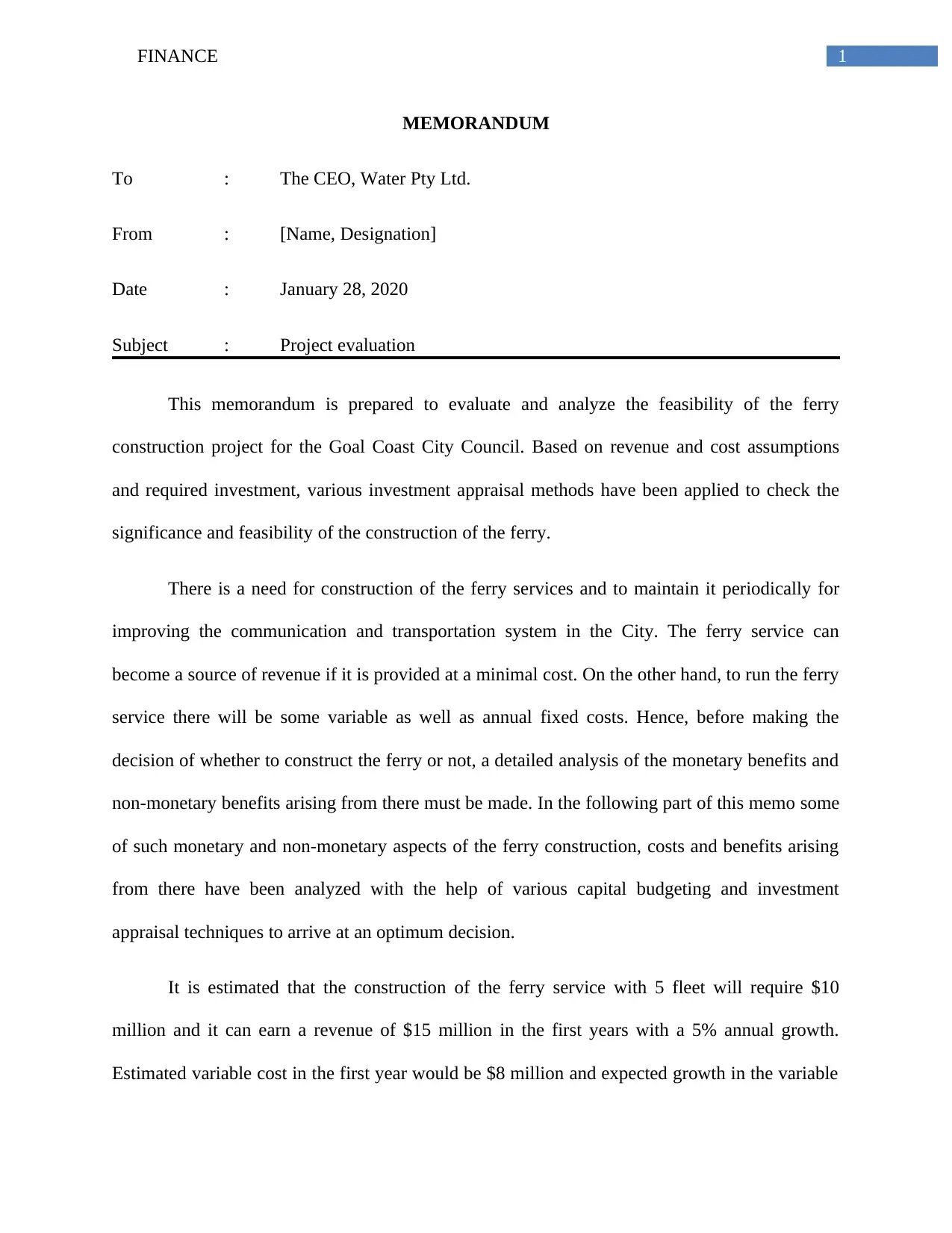
1FINANCE
MEMORANDUM
To : The CEO, Water Pty Ltd.
From : [Name, Designation]
Date : January 28, 2020
Subject : Project evaluation
This memorandum is prepared to evaluate and analyze the feasibility of the ferry
construction project for the Goal Coast City Council. Based on revenue and cost assumptions
and required investment, various investment appraisal methods have been applied to check the
significance and feasibility of the construction of the ferry.
There is a need for construction of the ferry services and to maintain it periodically for
improving the communication and transportation system in the City. The ferry service can
become a source of revenue if it is provided at a minimal cost. On the other hand, to run the ferry
service there will be some variable as well as annual fixed costs. Hence, before making the
decision of whether to construct the ferry or not, a detailed analysis of the monetary benefits and
non-monetary benefits arising from there must be made. In the following part of this memo some
of such monetary and non-monetary aspects of the ferry construction, costs and benefits arising
from there have been analyzed with the help of various capital budgeting and investment
appraisal techniques to arrive at an optimum decision.
It is estimated that the construction of the ferry service with 5 fleet will require $10
million and it can earn a revenue of $15 million in the first years with a 5% annual growth.
Estimated variable cost in the first year would be $8 million and expected growth in the variable
MEMORANDUM
To : The CEO, Water Pty Ltd.
From : [Name, Designation]
Date : January 28, 2020
Subject : Project evaluation
This memorandum is prepared to evaluate and analyze the feasibility of the ferry
construction project for the Goal Coast City Council. Based on revenue and cost assumptions
and required investment, various investment appraisal methods have been applied to check the
significance and feasibility of the construction of the ferry.
There is a need for construction of the ferry services and to maintain it periodically for
improving the communication and transportation system in the City. The ferry service can
become a source of revenue if it is provided at a minimal cost. On the other hand, to run the ferry
service there will be some variable as well as annual fixed costs. Hence, before making the
decision of whether to construct the ferry or not, a detailed analysis of the monetary benefits and
non-monetary benefits arising from there must be made. In the following part of this memo some
of such monetary and non-monetary aspects of the ferry construction, costs and benefits arising
from there have been analyzed with the help of various capital budgeting and investment
appraisal techniques to arrive at an optimum decision.
It is estimated that the construction of the ferry service with 5 fleet will require $10
million and it can earn a revenue of $15 million in the first years with a 5% annual growth.
Estimated variable cost in the first year would be $8 million and expected growth in the variable
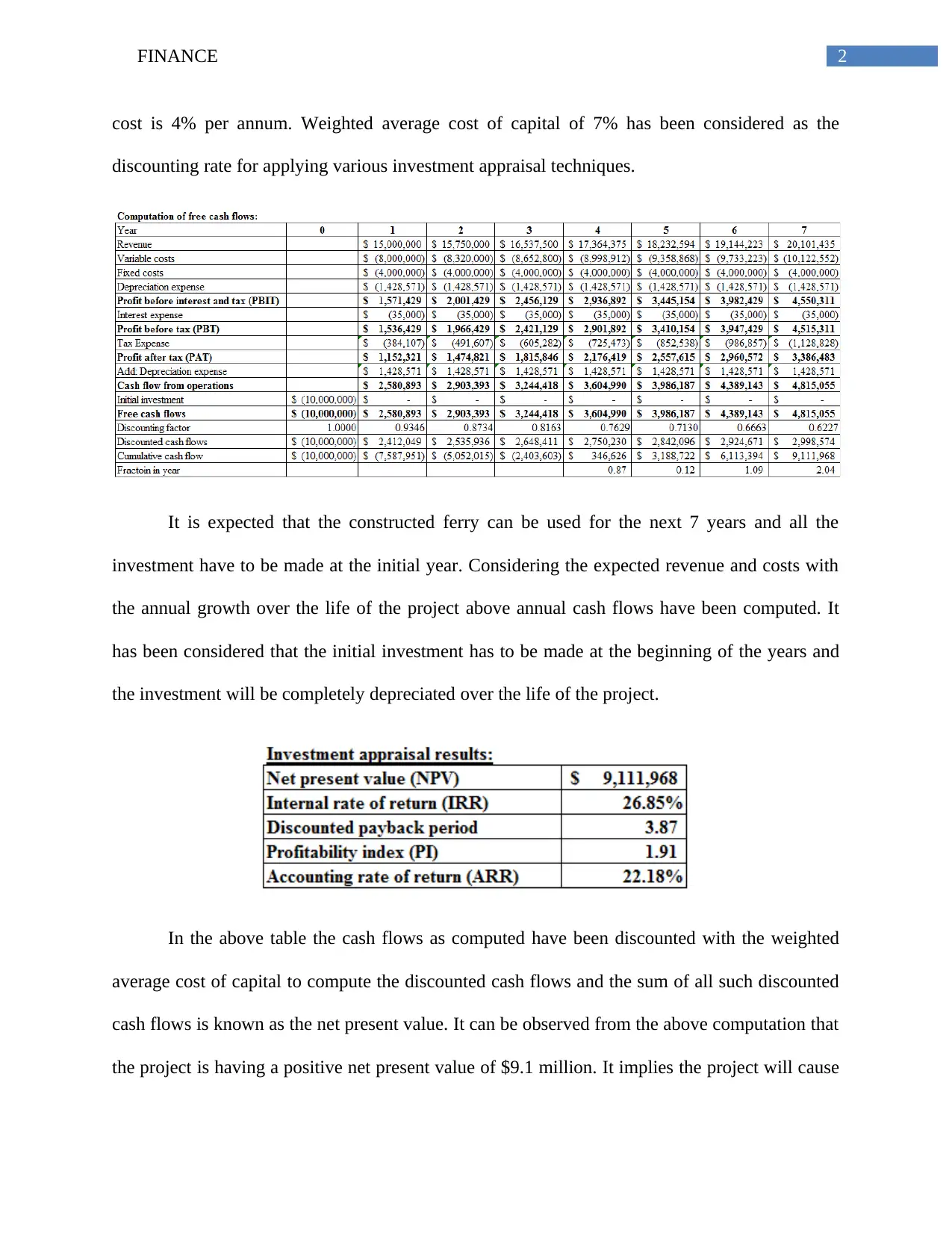
2FINANCE
cost is 4% per annum. Weighted average cost of capital of 7% has been considered as the
discounting rate for applying various investment appraisal techniques.
It is expected that the constructed ferry can be used for the next 7 years and all the
investment have to be made at the initial year. Considering the expected revenue and costs with
the annual growth over the life of the project above annual cash flows have been computed. It
has been considered that the initial investment has to be made at the beginning of the years and
the investment will be completely depreciated over the life of the project.
In the above table the cash flows as computed have been discounted with the weighted
average cost of capital to compute the discounted cash flows and the sum of all such discounted
cash flows is known as the net present value. It can be observed from the above computation that
the project is having a positive net present value of $9.1 million. It implies the project will cause
cost is 4% per annum. Weighted average cost of capital of 7% has been considered as the
discounting rate for applying various investment appraisal techniques.
It is expected that the constructed ferry can be used for the next 7 years and all the
investment have to be made at the initial year. Considering the expected revenue and costs with
the annual growth over the life of the project above annual cash flows have been computed. It
has been considered that the initial investment has to be made at the beginning of the years and
the investment will be completely depreciated over the life of the project.
In the above table the cash flows as computed have been discounted with the weighted
average cost of capital to compute the discounted cash flows and the sum of all such discounted
cash flows is known as the net present value. It can be observed from the above computation that
the project is having a positive net present value of $9.1 million. It implies the project will cause
⊘ This is a preview!⊘
Do you want full access?
Subscribe today to unlock all pages.

Trusted by 1+ million students worldwide
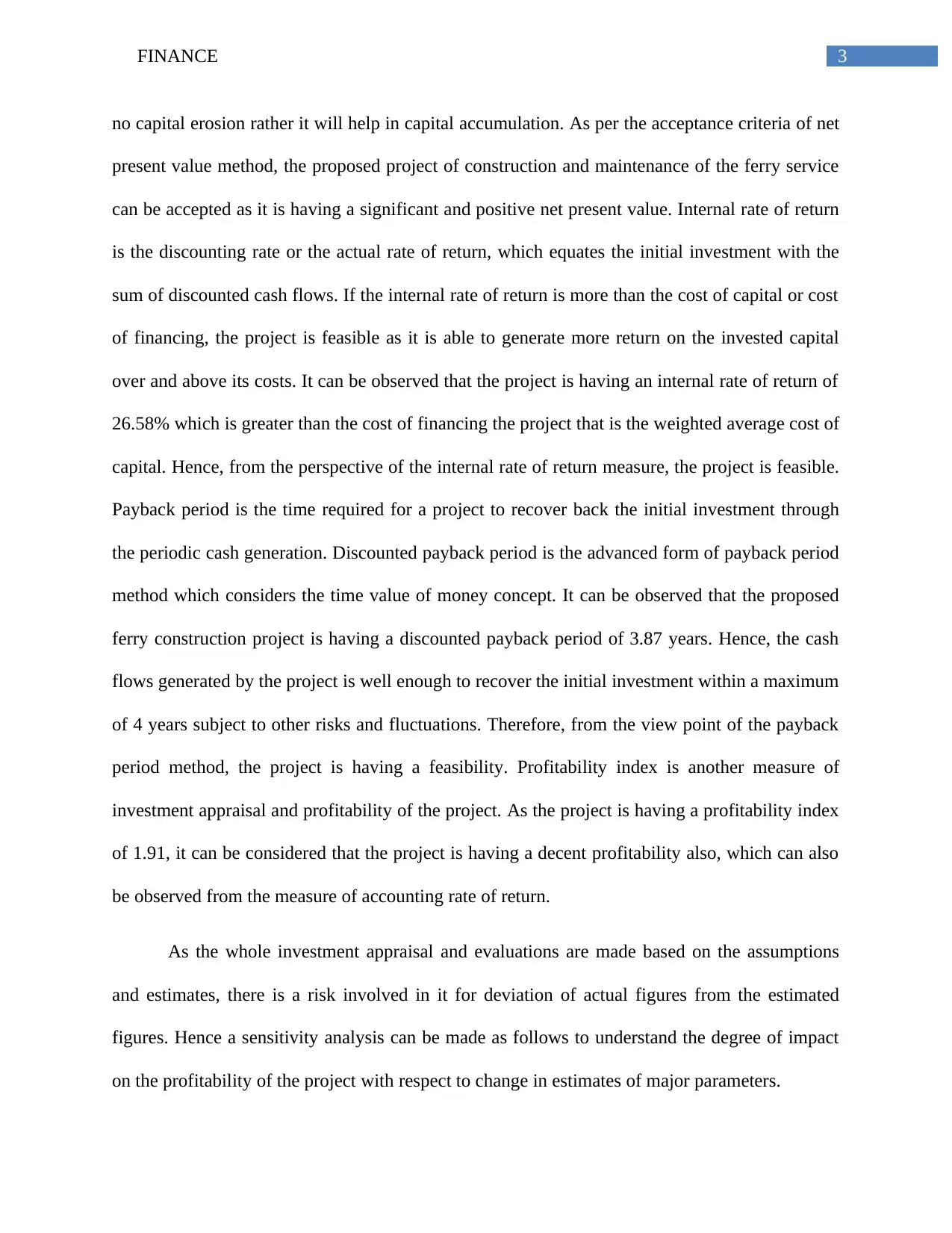
3FINANCE
no capital erosion rather it will help in capital accumulation. As per the acceptance criteria of net
present value method, the proposed project of construction and maintenance of the ferry service
can be accepted as it is having a significant and positive net present value. Internal rate of return
is the discounting rate or the actual rate of return, which equates the initial investment with the
sum of discounted cash flows. If the internal rate of return is more than the cost of capital or cost
of financing, the project is feasible as it is able to generate more return on the invested capital
over and above its costs. It can be observed that the project is having an internal rate of return of
26.58% which is greater than the cost of financing the project that is the weighted average cost of
capital. Hence, from the perspective of the internal rate of return measure, the project is feasible.
Payback period is the time required for a project to recover back the initial investment through
the periodic cash generation. Discounted payback period is the advanced form of payback period
method which considers the time value of money concept. It can be observed that the proposed
ferry construction project is having a discounted payback period of 3.87 years. Hence, the cash
flows generated by the project is well enough to recover the initial investment within a maximum
of 4 years subject to other risks and fluctuations. Therefore, from the view point of the payback
period method, the project is having a feasibility. Profitability index is another measure of
investment appraisal and profitability of the project. As the project is having a profitability index
of 1.91, it can be considered that the project is having a decent profitability also, which can also
be observed from the measure of accounting rate of return.
As the whole investment appraisal and evaluations are made based on the assumptions
and estimates, there is a risk involved in it for deviation of actual figures from the estimated
figures. Hence a sensitivity analysis can be made as follows to understand the degree of impact
on the profitability of the project with respect to change in estimates of major parameters.
no capital erosion rather it will help in capital accumulation. As per the acceptance criteria of net
present value method, the proposed project of construction and maintenance of the ferry service
can be accepted as it is having a significant and positive net present value. Internal rate of return
is the discounting rate or the actual rate of return, which equates the initial investment with the
sum of discounted cash flows. If the internal rate of return is more than the cost of capital or cost
of financing, the project is feasible as it is able to generate more return on the invested capital
over and above its costs. It can be observed that the project is having an internal rate of return of
26.58% which is greater than the cost of financing the project that is the weighted average cost of
capital. Hence, from the perspective of the internal rate of return measure, the project is feasible.
Payback period is the time required for a project to recover back the initial investment through
the periodic cash generation. Discounted payback period is the advanced form of payback period
method which considers the time value of money concept. It can be observed that the proposed
ferry construction project is having a discounted payback period of 3.87 years. Hence, the cash
flows generated by the project is well enough to recover the initial investment within a maximum
of 4 years subject to other risks and fluctuations. Therefore, from the view point of the payback
period method, the project is having a feasibility. Profitability index is another measure of
investment appraisal and profitability of the project. As the project is having a profitability index
of 1.91, it can be considered that the project is having a decent profitability also, which can also
be observed from the measure of accounting rate of return.
As the whole investment appraisal and evaluations are made based on the assumptions
and estimates, there is a risk involved in it for deviation of actual figures from the estimated
figures. Hence a sensitivity analysis can be made as follows to understand the degree of impact
on the profitability of the project with respect to change in estimates of major parameters.
Paraphrase This Document
Need a fresh take? Get an instant paraphrase of this document with our AI Paraphraser
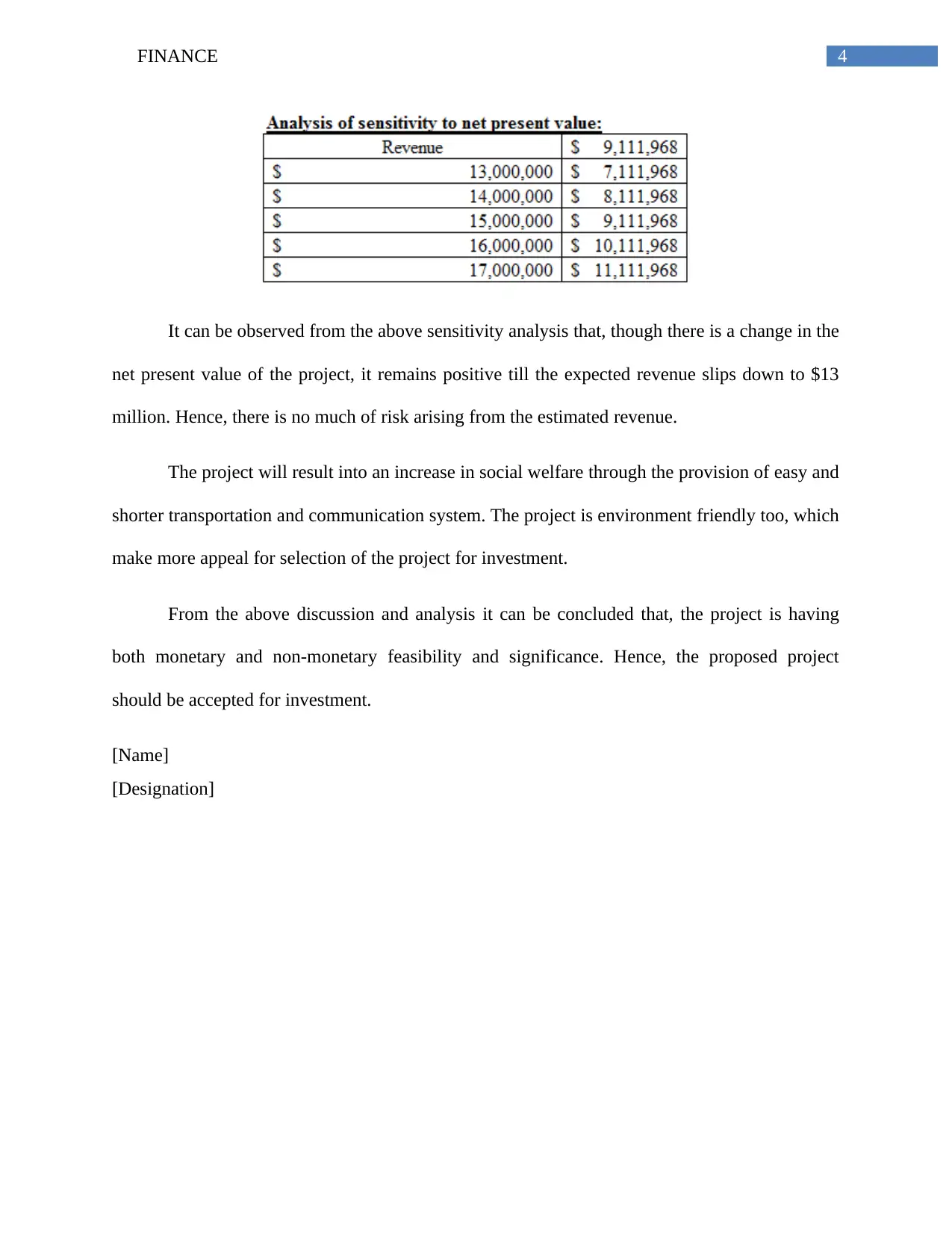
4FINANCE
It can be observed from the above sensitivity analysis that, though there is a change in the
net present value of the project, it remains positive till the expected revenue slips down to $13
million. Hence, there is no much of risk arising from the estimated revenue.
The project will result into an increase in social welfare through the provision of easy and
shorter transportation and communication system. The project is environment friendly too, which
make more appeal for selection of the project for investment.
From the above discussion and analysis it can be concluded that, the project is having
both monetary and non-monetary feasibility and significance. Hence, the proposed project
should be accepted for investment.
[Name]
[Designation]
It can be observed from the above sensitivity analysis that, though there is a change in the
net present value of the project, it remains positive till the expected revenue slips down to $13
million. Hence, there is no much of risk arising from the estimated revenue.
The project will result into an increase in social welfare through the provision of easy and
shorter transportation and communication system. The project is environment friendly too, which
make more appeal for selection of the project for investment.
From the above discussion and analysis it can be concluded that, the project is having
both monetary and non-monetary feasibility and significance. Hence, the proposed project
should be accepted for investment.
[Name]
[Designation]
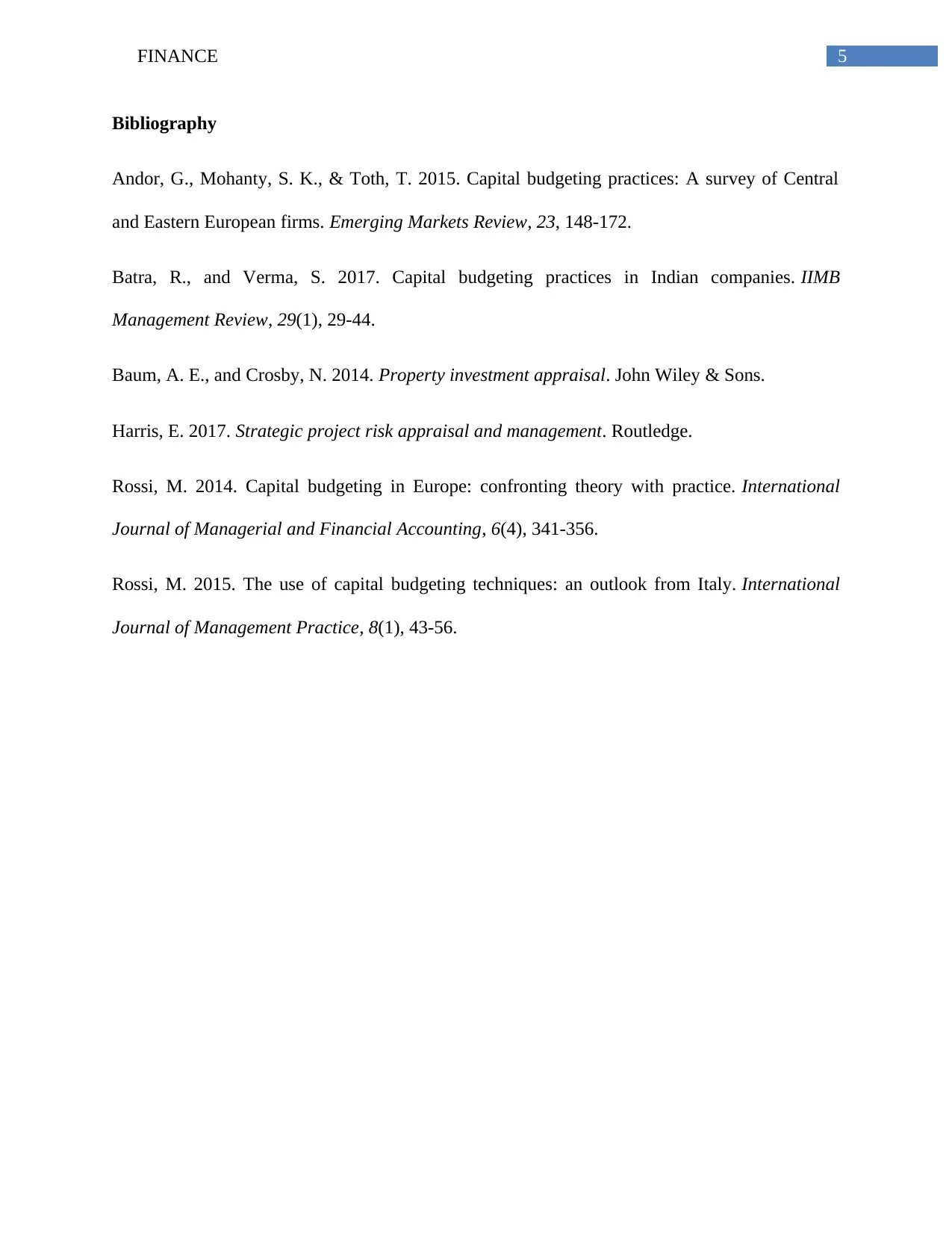
5FINANCE
Bibliography
Andor, G., Mohanty, S. K., & Toth, T. 2015. Capital budgeting practices: A survey of Central
and Eastern European firms. Emerging Markets Review, 23, 148-172.
Batra, R., and Verma, S. 2017. Capital budgeting practices in Indian companies. IIMB
Management Review, 29(1), 29-44.
Baum, A. E., and Crosby, N. 2014. Property investment appraisal. John Wiley & Sons.
Harris, E. 2017. Strategic project risk appraisal and management. Routledge.
Rossi, M. 2014. Capital budgeting in Europe: confronting theory with practice. International
Journal of Managerial and Financial Accounting, 6(4), 341-356.
Rossi, M. 2015. The use of capital budgeting techniques: an outlook from Italy. International
Journal of Management Practice, 8(1), 43-56.
Bibliography
Andor, G., Mohanty, S. K., & Toth, T. 2015. Capital budgeting practices: A survey of Central
and Eastern European firms. Emerging Markets Review, 23, 148-172.
Batra, R., and Verma, S. 2017. Capital budgeting practices in Indian companies. IIMB
Management Review, 29(1), 29-44.
Baum, A. E., and Crosby, N. 2014. Property investment appraisal. John Wiley & Sons.
Harris, E. 2017. Strategic project risk appraisal and management. Routledge.
Rossi, M. 2014. Capital budgeting in Europe: confronting theory with practice. International
Journal of Managerial and Financial Accounting, 6(4), 341-356.
Rossi, M. 2015. The use of capital budgeting techniques: an outlook from Italy. International
Journal of Management Practice, 8(1), 43-56.
⊘ This is a preview!⊘
Do you want full access?
Subscribe today to unlock all pages.

Trusted by 1+ million students worldwide
1 out of 6
Related Documents
Your All-in-One AI-Powered Toolkit for Academic Success.
+13062052269
info@desklib.com
Available 24*7 on WhatsApp / Email
![[object Object]](/_next/static/media/star-bottom.7253800d.svg)
Unlock your academic potential
Copyright © 2020–2025 A2Z Services. All Rights Reserved. Developed and managed by ZUCOL.





